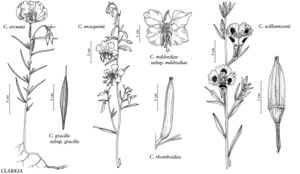Clarkia rhomboidea
Fl. Bor.-Amer. 1: 214. 1832.
Stems erect, to 100 cm, puberulent. Leaves: petiole 5–25 mm; blade lanceolate to elliptic or ovate, 1–6 cm. Inflorescences open racemes, axis in bud recurved 1–3 nodes distal to open flowers; buds pendent, narrowly obovoid, tip acute to obtuse, often curved to one side. Flowers: floral-tube 1–3 mm; sepals reflexed individually; corolla rotate, petals pinkish lavender, often with darker flecks, narrowly to broadly obovate or rhombic, sometimes ± 3-lobed, 6–12 (–14) × 3–7 mm; stamens 8, subequal, subtended by ciliate scales, pollen blue-gray; ovary shallowly 4-grooved; stigma not or rarely exserted beyond anthers. Capsules 10–25 mm; pedicel 1–4 mm. Seeds brown, gray, or mottled, 1–1.5 mm, scaly-echinate, crest 0.1 mm, inconspicuous. 2n = 24.
Phenology: Flowering May–Sep.
Habitat: Yellow-pine forests, woodlands.
Elevation: 0–3000 m.
Distribution
Ariz., Calif., Idaho, Mont., Nev., Oreg., Utah, Wash., Mexico (Baja California)
Discussion
Clarkia rhomboidea is a tetraploid derived from C. mildrediae and C. virgata or a closely related species. The six diploid species in sect. Myxocarpa closely related to C. rhomboidea (C. australis, C. borealis, C. mildrediae, C. mosquinii, C. stellata, and C. virgata) are California endemics with relatively small areas of distribution, whereas C. rhomboidea occurs throughout much of the western United States and is morphologically much more variable. Clarkia rhomboidea characteristically has relatively small, self-pollinating flowers with the stigma in contact with the anthers. Among the diploid species only C. stellata has similar small, self-pollinating flowers but is distinguished by yellow pollen and petals with a shallowly 3-lobed blade that is not flecked. Rare populations of C. rhomboidea have relatively large flowers with the stigma exserted beyond the anthers. When they occur within the geographical range of the outcrossing diploid species, they may be difficult to distinguish without determining chromosome number.
Selected References
None.
